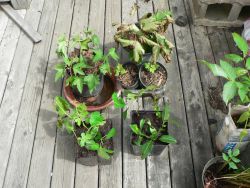Food forests are undeniably sexy right now in Permaculture circles. A great compliment to a regular raised garden of annual vegetables, food forests pack a lot of food sources into a small space, using different height-plants that help each other out, while benefiting soil and wild life.
But what do you do when you just don't have the funds for the latest cultivars of fruit and nut bearing trees and shrubs? Behold the free food forest planting guide!
To design a food forest on the cheap, we make use of plants that either come up from plentiful (=easily available) seeds, or clones.
You may have heard of the practice of cloning while learning about more illegal plants. But many herbs and trees can also be cloned; in nature, it's a major plant-reproducing strategy.
Some times twigs (or even sometimes leaves) broken or cut from trees and shrubs will grow roots and become a whole new tree or shrub. Other times, we can stab a shovel down the middle of the plant and cut the root-ball into two or more pieces, a process known as "dividing".
You can probably find friends willing to divide edible ornamental like Solomon seal, daylilly or hosta, and you can almost certainly find an owner of grape, hops and hardy kiwi willing to part with some prunings to clone. Thinnings of strawberries, raspberries, blackberries and thimbleberries are easy to come by as people cultivating these fruit often need to thin them.
Nursery season-end sales are also good to check in July and August.
Even volunteer white oak and mountain ash can be found sprouting beneath their parent trees if these tickle your fancy for an emergency food supply. Some perennial vegetables can be started from roots and leaves available at specialty grocery stores, like watercress, sunchokes and oyster root.
Finally, Perennial vegetables can be got from further afield from progressive nurseries and seed suppliers. It is my hope to make an initial investment to bring these varieties to Nova Scotia for further propagation to jump start local food forests. Plants like salad burnet, ice cream bean, cinnamon yam, tuber pea, perennial parsley, perennial sea kale, bush cherry, hardy passionfruit, hardy kiwi, wooly lambs ear tuber, rapunzel, potato bunching onion, skirret and hardy pecan.
Some locations I hope to plant this year with guilds and/or food forests include:
Transition Bay St Margarets
Annapolis seeds in Nictaux
Cherrybrook
The Open Mic House on Agricola street
There will be shout-outs and volunteer opportunities as spring advances so keep your eye out for those.
Some perennial vegetable purveyors
as well as more traditional nurseries if you know what you are looking for.
Gardeners around North America this year were thrilled to learn about The paw paw project. Kentucky State University are distributing 30 thousand paw paw seeds in the hopes of more widely distributing paw paw trees throughout their range and foster their diversity and strength. You can contact them here
To get your own free pawpaw seeds. Of course if you help support the project you will get on the seed distribution priority shortlist!
A by-no-means exhaustive list of easy-to-obtain plants to clone for your own
Trees and shrubs that can be cloned
Beech, dogwood, willow, alder
Hawthorn, Elder, Mulberry, Currant, Gooseberry
Autumn olive, Sea buckthorn
Hazel, Sweet fern
Food-providing Herbs that can be divided or that spread
Anything mint: lemonbalm, cat nip, bee balm, chocolate mint, apple mint, horse mint, thymes, oregano, anise hyssop
Alliums: chives, garlic chives, society garlic, golden garlic, Egyptian Walking Onions
Miscellaneous perennials: ostrich fern, hostas, may apple, Solomon seal, wintergreen, rhubarb, echinacea, sweet cicely, Comfrey, yarrow, horseradish, daylilly, good king Henry, all raspberries and blackberries, many roses, strawberries, and more.
Easily started from seed and self seeding
Nasturtiums, violets, calendula
globe thistle, rudbeckia
artemisia, columbine
musk mallow
feverfew
wintercress
borage
Not edible but useful for pollinators and/or fixing nitrogen
lupine, daffodil, scilla
This is a great website for all things food forest




